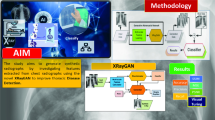Abstract
In this work, we exploit the unsupervised domain adaptation problem for radiology image interpretation across domains. Specifically, we study how to adapt the disease recognition model from a labeled source domain to an unlabeled target domain, so as to reduce the effort of labeling each new dataset. To address the shortcoming of cross-domain, unpaired image-to-image translation methods which typically ignore class-specific semantics, we propose a task-driven, discriminatively trained, cycle-consistent generative adversarial network, termed TUNA-Net. It is able to preserve (1) low-level details, (2) high-level semantic information and (3) mid-level feature representation during the image-to-image translation process, to favor the target disease recognition task. The TUNA-Net framework is general and can be readily adapted to other learning tasks. We evaluate the proposed framework on two public chest X-ray datasets for pneumonia recognition. The TUNA-Net model can adapt labeled adult chest X-rays in the source domain such that they appear as if they were drawn from pediatric X-rays in the unlabeled target domain, while preserving the disease semantics. Extensive experiments show the superiority of the proposed method as compared to state-of-the-art unsupervised domain adaptation approaches. Notably, TUNA-Net achieves an AUC of 96.3% for pediatric pneumonia classification, which is very close to that of the supervised approach (98.1%), but without the need for labels on the target domain.
Access this chapter
Tax calculation will be finalised at checkout
Purchases are for personal use only
Similar content being viewed by others
References
Chen, C., Dou, Q., Chen, H., Heng, P.-A.: Semantic-aware generative adversarial nets for unsupervised domain adaptation in chest X-ray segmentation. In: Shi, Y., Suk, H.-I., Liu, M. (eds.) MLMI 2018. LNCS, vol. 11046, pp. 143–151. Springer, Cham (2018). https://doi.org/10.1007/978-3-030-00919-9_17
Ghafoorian, M., et al.: Transfer learning for domain adaptation in MRI: application in brain lesion segmentation. In: Descoteaux, M., Maier-Hein, L., Franz, A., Jannin, P., Collins, D.L., Duchesne, S. (eds.) MICCAI 2017. LNCS, vol. 10435, pp. 516–524. Springer, Cham (2017). https://doi.org/10.1007/978-3-319-66179-7_59
Goodfellow, I., et al.: Generative adversarial nets. In: NIPS (2014)
He, K., et al.: Deep residual learning for image recognition. In: CVPR (2016)
Hoffman, J., et al.: CyCADA: cycle consistent adversarial domain adaptation. In: ICML (2018)
Johnson, J., Alahi, A., Fei-Fei, L.: Perceptual losses for real-time style transfer and super-resolution. In: Leibe, B., Matas, J., Sebe, N., Welling, M. (eds.) ECCV 2016. LNCS, vol. 9906, pp. 694–711. Springer, Cham (2016). https://doi.org/10.1007/978-3-319-46475-6_43
Kamnitsas, K., et al.: Unsupervised domain adaptation in brain lesion segmentation with adversarial networks. In: Niethammer, M., et al. (eds.) IPMI 2017. LNCS, vol. 10265, pp. 597–609. Springer, Cham (2017). https://doi.org/10.1007/978-3-319-59050-9_47
Tang, Y.X., et al.: Deep adversarial one-class learning for normal and abnormal chest radiograph classification. In: Medical Imaging: CAD (2019)
Tang, Y., Wang, X., Harrison, A.P., Lu, L., **ao, J., Summers, R.M.: Attention-guided curriculum learning for weakly supervised classification and localization of thoracic diseases on chest radiographs. In: Shi, Y., Suk, H.-I., Liu, M. (eds.) MLMI 2018. LNCS, vol. 11046, pp. 249–258. Springer, Cham (2018). https://doi.org/10.1007/978-3-030-00919-9_29
Tzeng, E., et al.: Adversarial discriminative domain adaptation. In: CVPR (2017)
Wang, X., et al.: ChestX-ray8: hospital-scale chest X-ray database and benchmarks on weakly-supervised classification and localization of common thorax diseases. In: CVPR (2017)
Zhang, Y., Miao, S., Mansi, T., Liao, R.: Task driven generative modeling for unsupervised domain adaptation: application to X-ray image segmentation. In: Frangi, A.F., Schnabel, J.A., Davatzikos, C., Alberola-López, C., Fichtinger, G. (eds.) MICCAI 2018. LNCS, vol. 11071, pp. 599–607. Springer, Cham (2018). https://doi.org/10.1007/978-3-030-00934-2_67
Zhang, Z., et al.: Translating and segmenting multimodal medical volumes with cycle- and shape-consistency generative adversarial network. In: CVPR (2018)
Zhu, J.Y., et al.: Unpaired image-to-image translation using cycle-consistent adversarial networks. In: ICCV (2017)
Acknowledgments
This research was supported by the Intramural Research Program of the National Institutes of Health Clinical Center and by the ** An Technology Co., Ltd. through a Cooperative Research and Development Agreement. The authors thank NVIDIA for GPU donations.
Author information
Authors and Affiliations
Corresponding author
Editor information
Editors and Affiliations
1 Electronic supplementary material
Below is the link to the electronic supplementary material.
Rights and permissions
Copyright information
© 2019 This is a U.S. government work and not under copyright protection in the U.S.; foreign copyright protection may apply
About this paper
Cite this paper
Tang, Y., Tang, Y., Sandfort, V., **ao, J., Summers, R.M. (2019). TUNA-Net: Task-Oriented UNsupervised Adversarial Network for Disease Recognition in Cross-domain Chest X-rays. In: Shen, D., et al. Medical Image Computing and Computer Assisted Intervention – MICCAI 2019. MICCAI 2019. Lecture Notes in Computer Science(), vol 11769. Springer, Cham. https://doi.org/10.1007/978-3-030-32226-7_48
Download citation
DOI: https://doi.org/10.1007/978-3-030-32226-7_48
Published:
Publisher Name: Springer, Cham
Print ISBN: 978-3-030-32225-0
Online ISBN: 978-3-030-32226-7
eBook Packages: Computer ScienceComputer Science (R0)





